Retail Supply Chain: Strategies, E-commerce, and Outsourcing
VerifiedAdded on 2020/01/23
|15
|4982
|500
Report
AI Summary
This report provides a comprehensive overview of supply chain management within the retail industry. It begins by defining the supply chain and highlighting its complexities, particularly within the context of grocery retail. The report then delves into various supply chain strategies, including demand-driven planning, adaptive supply chains, optimized designs, and the alignment of supply chains with business objectives and sustainability goals. Furthermore, it explores the impact of e-commerce and information systems on retail supply chains, addressing challenges such as inventory management, supply chain visibility, distribution, and information technology. The report also discusses the role of outsourcing in streamlining operations and reducing costs. Finally, it covers supply chain relationships and improvements, offering a holistic view of supply chain management in the retail sector, and providing insights into how retail companies can navigate the challenges and optimize their supply chains for efficiency and customer satisfaction.
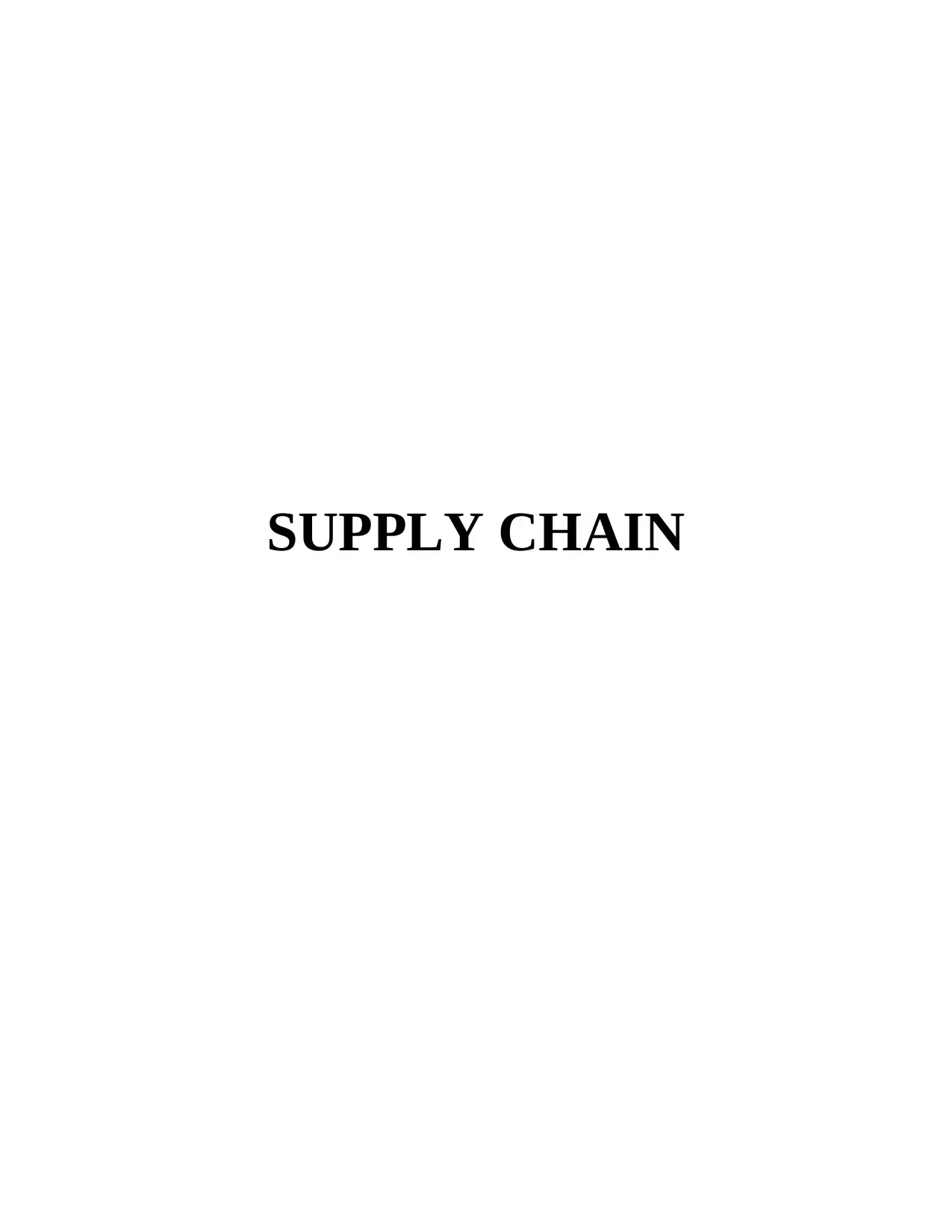
SUPPLY CHAIN
Paraphrase This Document
Need a fresh take? Get an instant paraphrase of this document with our AI Paraphraser
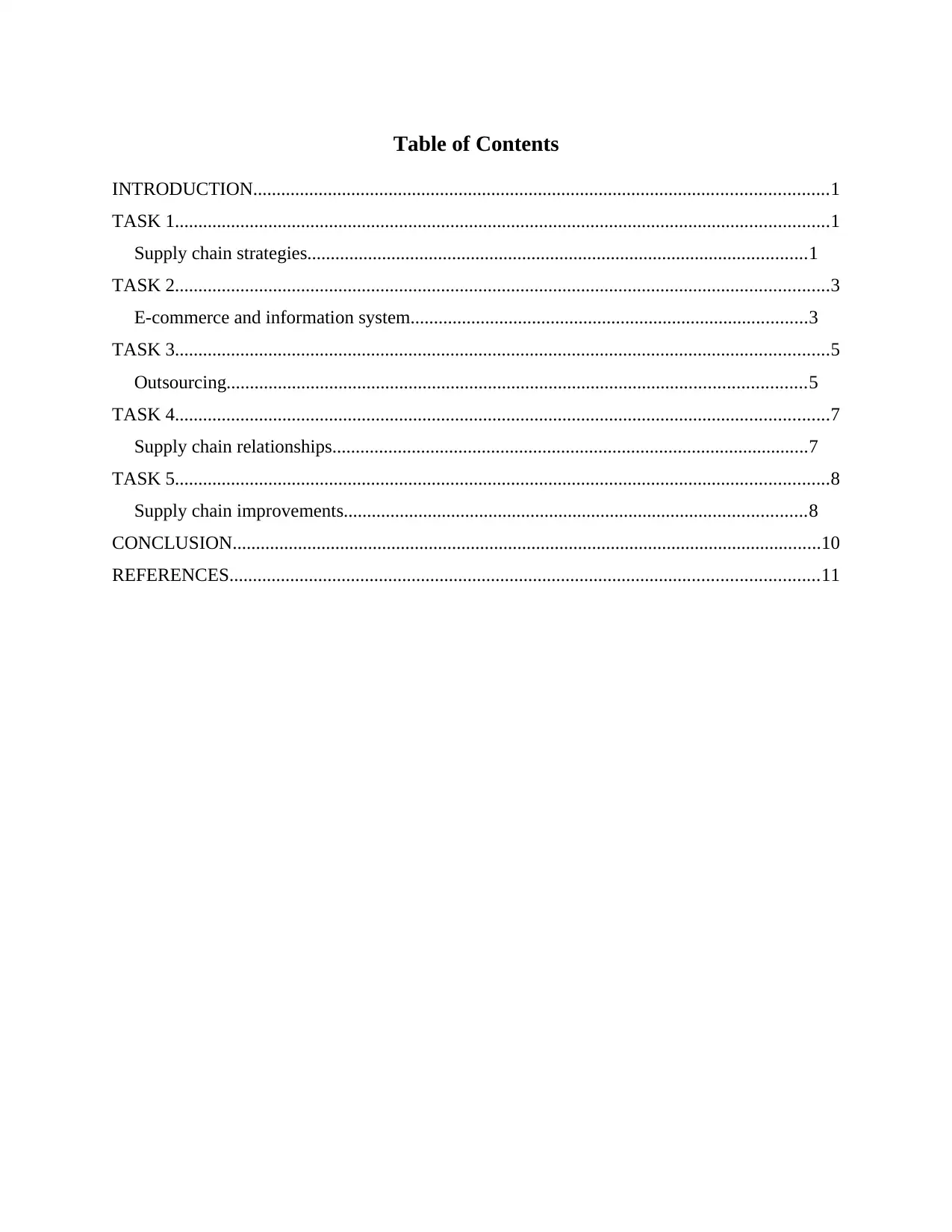
Table of Contents
INTRODUCTION...........................................................................................................................1
TASK 1............................................................................................................................................1
Supply chain strategies...........................................................................................................1
TASK 2............................................................................................................................................3
E-commerce and information system.....................................................................................3
TASK 3............................................................................................................................................5
Outsourcing............................................................................................................................5
TASK 4............................................................................................................................................7
Supply chain relationships......................................................................................................7
TASK 5............................................................................................................................................8
Supply chain improvements...................................................................................................8
CONCLUSION..............................................................................................................................10
REFERENCES..............................................................................................................................11
INTRODUCTION...........................................................................................................................1
TASK 1............................................................................................................................................1
Supply chain strategies...........................................................................................................1
TASK 2............................................................................................................................................3
E-commerce and information system.....................................................................................3
TASK 3............................................................................................................................................5
Outsourcing............................................................................................................................5
TASK 4............................................................................................................................................7
Supply chain relationships......................................................................................................7
TASK 5............................................................................................................................................8
Supply chain improvements...................................................................................................8
CONCLUSION..............................................................................................................................10
REFERENCES..............................................................................................................................11

⊘ This is a preview!⊘
Do you want full access?
Subscribe today to unlock all pages.

Trusted by 1+ million students worldwide
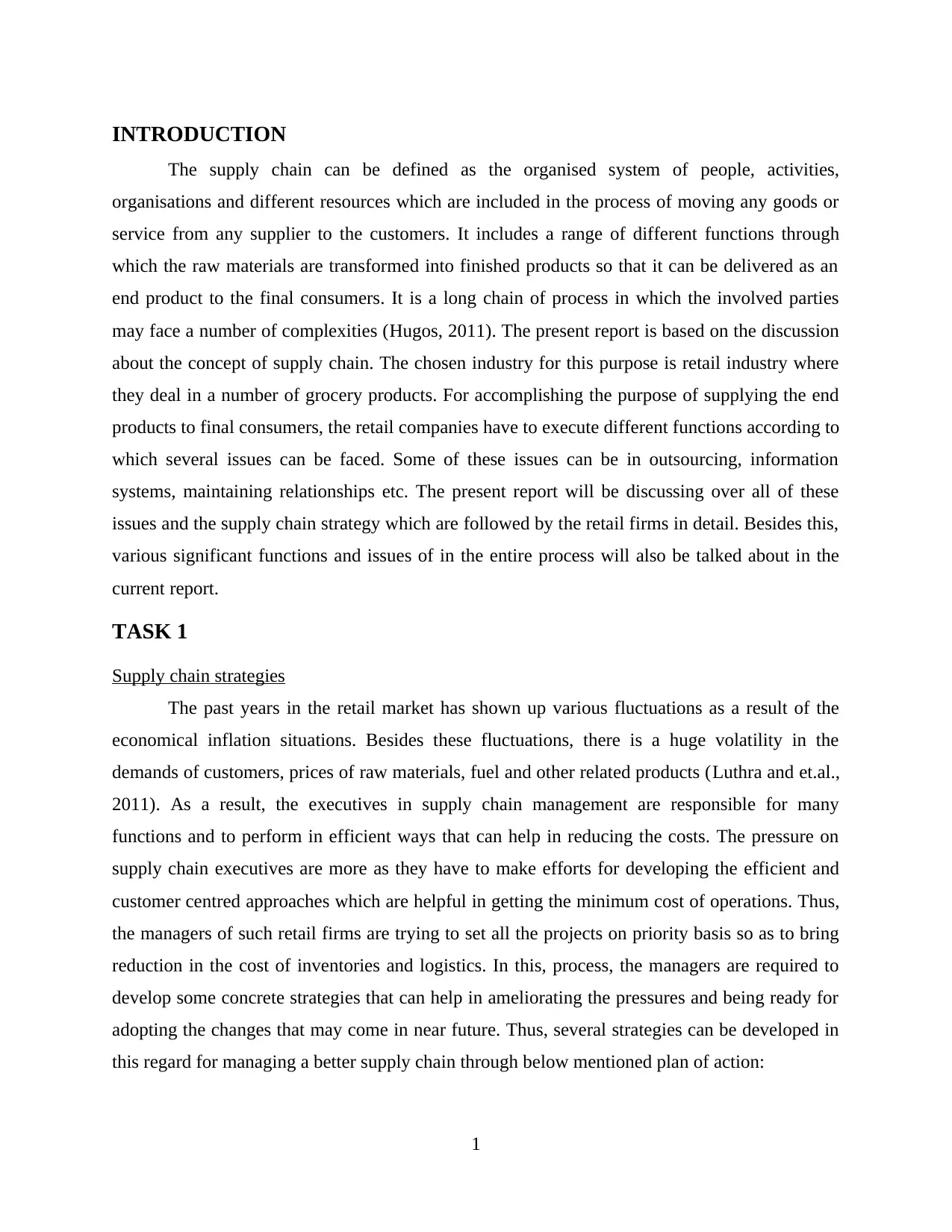
INTRODUCTION
The supply chain can be defined as the organised system of people, activities,
organisations and different resources which are included in the process of moving any goods or
service from any supplier to the customers. It includes a range of different functions through
which the raw materials are transformed into finished products so that it can be delivered as an
end product to the final consumers. It is a long chain of process in which the involved parties
may face a number of complexities (Hugos, 2011). The present report is based on the discussion
about the concept of supply chain. The chosen industry for this purpose is retail industry where
they deal in a number of grocery products. For accomplishing the purpose of supplying the end
products to final consumers, the retail companies have to execute different functions according to
which several issues can be faced. Some of these issues can be in outsourcing, information
systems, maintaining relationships etc. The present report will be discussing over all of these
issues and the supply chain strategy which are followed by the retail firms in detail. Besides this,
various significant functions and issues of in the entire process will also be talked about in the
current report.
TASK 1
Supply chain strategies
The past years in the retail market has shown up various fluctuations as a result of the
economical inflation situations. Besides these fluctuations, there is a huge volatility in the
demands of customers, prices of raw materials, fuel and other related products (Luthra and et.al.,
2011). As a result, the executives in supply chain management are responsible for many
functions and to perform in efficient ways that can help in reducing the costs. The pressure on
supply chain executives are more as they have to make efforts for developing the efficient and
customer centred approaches which are helpful in getting the minimum cost of operations. Thus,
the managers of such retail firms are trying to set all the projects on priority basis so as to bring
reduction in the cost of inventories and logistics. In this, process, the managers are required to
develop some concrete strategies that can help in ameliorating the pressures and being ready for
adopting the changes that may come in near future. Thus, several strategies can be developed in
this regard for managing a better supply chain through below mentioned plan of action:
1
The supply chain can be defined as the organised system of people, activities,
organisations and different resources which are included in the process of moving any goods or
service from any supplier to the customers. It includes a range of different functions through
which the raw materials are transformed into finished products so that it can be delivered as an
end product to the final consumers. It is a long chain of process in which the involved parties
may face a number of complexities (Hugos, 2011). The present report is based on the discussion
about the concept of supply chain. The chosen industry for this purpose is retail industry where
they deal in a number of grocery products. For accomplishing the purpose of supplying the end
products to final consumers, the retail companies have to execute different functions according to
which several issues can be faced. Some of these issues can be in outsourcing, information
systems, maintaining relationships etc. The present report will be discussing over all of these
issues and the supply chain strategy which are followed by the retail firms in detail. Besides this,
various significant functions and issues of in the entire process will also be talked about in the
current report.
TASK 1
Supply chain strategies
The past years in the retail market has shown up various fluctuations as a result of the
economical inflation situations. Besides these fluctuations, there is a huge volatility in the
demands of customers, prices of raw materials, fuel and other related products (Luthra and et.al.,
2011). As a result, the executives in supply chain management are responsible for many
functions and to perform in efficient ways that can help in reducing the costs. The pressure on
supply chain executives are more as they have to make efforts for developing the efficient and
customer centred approaches which are helpful in getting the minimum cost of operations. Thus,
the managers of such retail firms are trying to set all the projects on priority basis so as to bring
reduction in the cost of inventories and logistics. In this, process, the managers are required to
develop some concrete strategies that can help in ameliorating the pressures and being ready for
adopting the changes that may come in near future. Thus, several strategies can be developed in
this regard for managing a better supply chain through below mentioned plan of action:
1
Paraphrase This Document
Need a fresh take? Get an instant paraphrase of this document with our AI Paraphraser
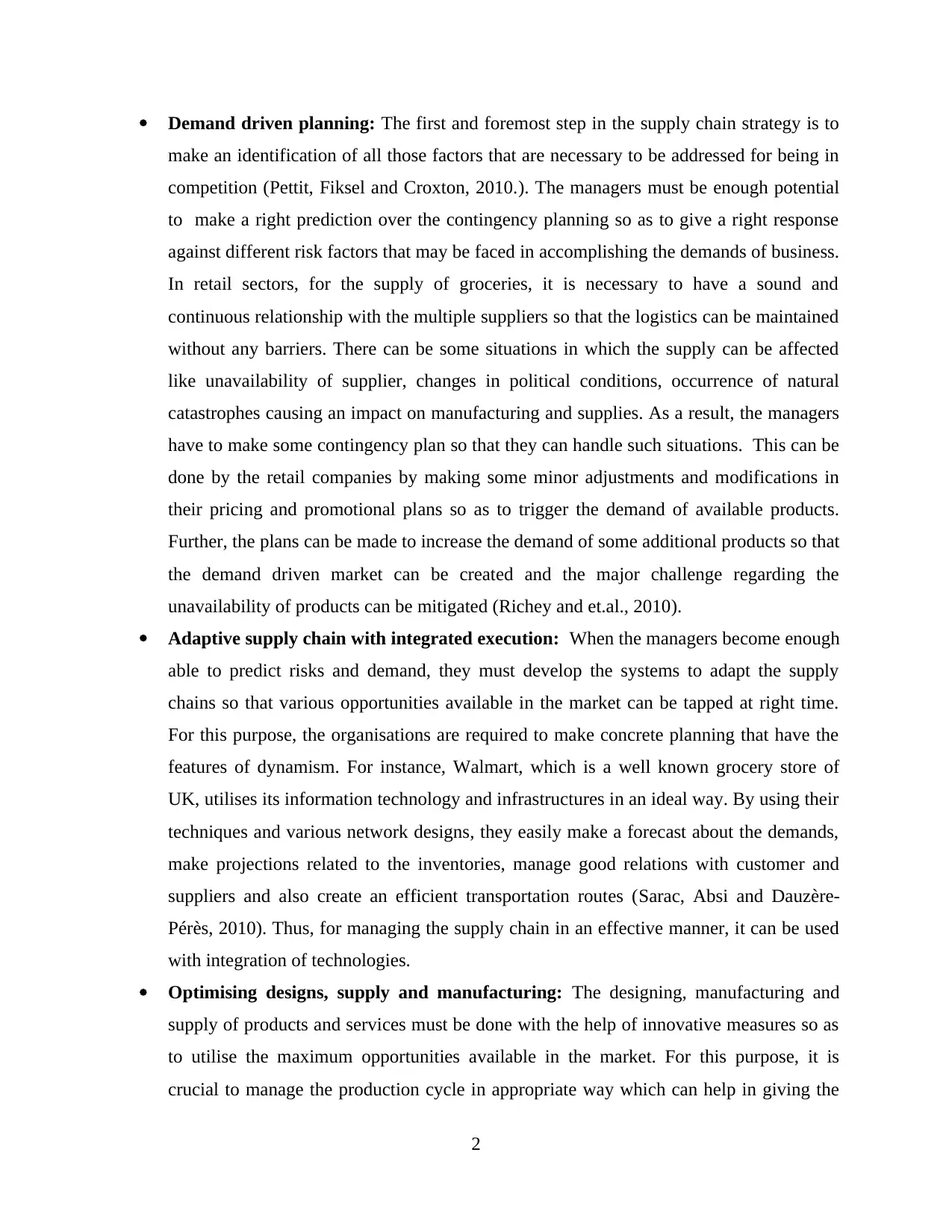
Demand driven planning: The first and foremost step in the supply chain strategy is to
make an identification of all those factors that are necessary to be addressed for being in
competition (Pettit, Fiksel and Croxton, 2010.). The managers must be enough potential
to make a right prediction over the contingency planning so as to give a right response
against different risk factors that may be faced in accomplishing the demands of business.
In retail sectors, for the supply of groceries, it is necessary to have a sound and
continuous relationship with the multiple suppliers so that the logistics can be maintained
without any barriers. There can be some situations in which the supply can be affected
like unavailability of supplier, changes in political conditions, occurrence of natural
catastrophes causing an impact on manufacturing and supplies. As a result, the managers
have to make some contingency plan so that they can handle such situations. This can be
done by the retail companies by making some minor adjustments and modifications in
their pricing and promotional plans so as to trigger the demand of available products.
Further, the plans can be made to increase the demand of some additional products so that
the demand driven market can be created and the major challenge regarding the
unavailability of products can be mitigated (Richey and et.al., 2010).
Adaptive supply chain with integrated execution: When the managers become enough
able to predict risks and demand, they must develop the systems to adapt the supply
chains so that various opportunities available in the market can be tapped at right time.
For this purpose, the organisations are required to make concrete planning that have the
features of dynamism. For instance, Walmart, which is a well known grocery store of
UK, utilises its information technology and infrastructures in an ideal way. By using their
techniques and various network designs, they easily make a forecast about the demands,
make projections related to the inventories, manage good relations with customer and
suppliers and also create an efficient transportation routes (Sarac, Absi and Dauzère-
Pérès, 2010). Thus, for managing the supply chain in an effective manner, it can be used
with integration of technologies.
Optimising designs, supply and manufacturing: The designing, manufacturing and
supply of products and services must be done with the help of innovative measures so as
to utilise the maximum opportunities available in the market. For this purpose, it is
crucial to manage the production cycle in appropriate way which can help in giving the
2
make an identification of all those factors that are necessary to be addressed for being in
competition (Pettit, Fiksel and Croxton, 2010.). The managers must be enough potential
to make a right prediction over the contingency planning so as to give a right response
against different risk factors that may be faced in accomplishing the demands of business.
In retail sectors, for the supply of groceries, it is necessary to have a sound and
continuous relationship with the multiple suppliers so that the logistics can be maintained
without any barriers. There can be some situations in which the supply can be affected
like unavailability of supplier, changes in political conditions, occurrence of natural
catastrophes causing an impact on manufacturing and supplies. As a result, the managers
have to make some contingency plan so that they can handle such situations. This can be
done by the retail companies by making some minor adjustments and modifications in
their pricing and promotional plans so as to trigger the demand of available products.
Further, the plans can be made to increase the demand of some additional products so that
the demand driven market can be created and the major challenge regarding the
unavailability of products can be mitigated (Richey and et.al., 2010).
Adaptive supply chain with integrated execution: When the managers become enough
able to predict risks and demand, they must develop the systems to adapt the supply
chains so that various opportunities available in the market can be tapped at right time.
For this purpose, the organisations are required to make concrete planning that have the
features of dynamism. For instance, Walmart, which is a well known grocery store of
UK, utilises its information technology and infrastructures in an ideal way. By using their
techniques and various network designs, they easily make a forecast about the demands,
make projections related to the inventories, manage good relations with customer and
suppliers and also create an efficient transportation routes (Sarac, Absi and Dauzère-
Pérès, 2010). Thus, for managing the supply chain in an effective manner, it can be used
with integration of technologies.
Optimising designs, supply and manufacturing: The designing, manufacturing and
supply of products and services must be done with the help of innovative measures so as
to utilise the maximum opportunities available in the market. For this purpose, it is
crucial to manage the production cycle in appropriate way which can help in giving the
2
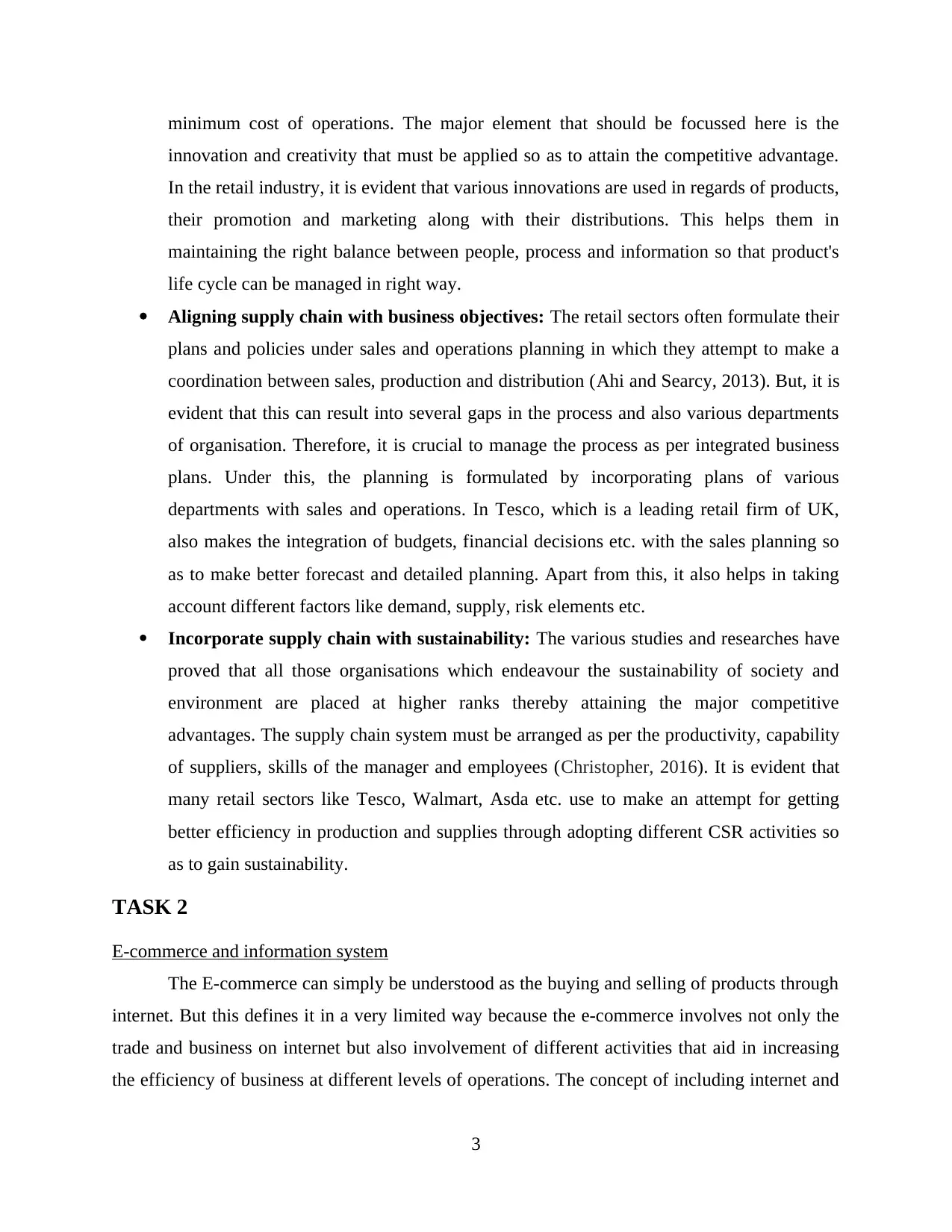
minimum cost of operations. The major element that should be focussed here is the
innovation and creativity that must be applied so as to attain the competitive advantage.
In the retail industry, it is evident that various innovations are used in regards of products,
their promotion and marketing along with their distributions. This helps them in
maintaining the right balance between people, process and information so that product's
life cycle can be managed in right way.
Aligning supply chain with business objectives: The retail sectors often formulate their
plans and policies under sales and operations planning in which they attempt to make a
coordination between sales, production and distribution (Ahi and Searcy, 2013). But, it is
evident that this can result into several gaps in the process and also various departments
of organisation. Therefore, it is crucial to manage the process as per integrated business
plans. Under this, the planning is formulated by incorporating plans of various
departments with sales and operations. In Tesco, which is a leading retail firm of UK,
also makes the integration of budgets, financial decisions etc. with the sales planning so
as to make better forecast and detailed planning. Apart from this, it also helps in taking
account different factors like demand, supply, risk elements etc.
Incorporate supply chain with sustainability: The various studies and researches have
proved that all those organisations which endeavour the sustainability of society and
environment are placed at higher ranks thereby attaining the major competitive
advantages. The supply chain system must be arranged as per the productivity, capability
of suppliers, skills of the manager and employees (Christopher, 2016). It is evident that
many retail sectors like Tesco, Walmart, Asda etc. use to make an attempt for getting
better efficiency in production and supplies through adopting different CSR activities so
as to gain sustainability.
TASK 2
E-commerce and information system
The E-commerce can simply be understood as the buying and selling of products through
internet. But this defines it in a very limited way because the e-commerce involves not only the
trade and business on internet but also involvement of different activities that aid in increasing
the efficiency of business at different levels of operations. The concept of including internet and
3
innovation and creativity that must be applied so as to attain the competitive advantage.
In the retail industry, it is evident that various innovations are used in regards of products,
their promotion and marketing along with their distributions. This helps them in
maintaining the right balance between people, process and information so that product's
life cycle can be managed in right way.
Aligning supply chain with business objectives: The retail sectors often formulate their
plans and policies under sales and operations planning in which they attempt to make a
coordination between sales, production and distribution (Ahi and Searcy, 2013). But, it is
evident that this can result into several gaps in the process and also various departments
of organisation. Therefore, it is crucial to manage the process as per integrated business
plans. Under this, the planning is formulated by incorporating plans of various
departments with sales and operations. In Tesco, which is a leading retail firm of UK,
also makes the integration of budgets, financial decisions etc. with the sales planning so
as to make better forecast and detailed planning. Apart from this, it also helps in taking
account different factors like demand, supply, risk elements etc.
Incorporate supply chain with sustainability: The various studies and researches have
proved that all those organisations which endeavour the sustainability of society and
environment are placed at higher ranks thereby attaining the major competitive
advantages. The supply chain system must be arranged as per the productivity, capability
of suppliers, skills of the manager and employees (Christopher, 2016). It is evident that
many retail sectors like Tesco, Walmart, Asda etc. use to make an attempt for getting
better efficiency in production and supplies through adopting different CSR activities so
as to gain sustainability.
TASK 2
E-commerce and information system
The E-commerce can simply be understood as the buying and selling of products through
internet. But this defines it in a very limited way because the e-commerce involves not only the
trade and business on internet but also involvement of different activities that aid in increasing
the efficiency of business at different levels of operations. The concept of including internet and
3
⊘ This is a preview!⊘
Do you want full access?
Subscribe today to unlock all pages.

Trusted by 1+ million students worldwide
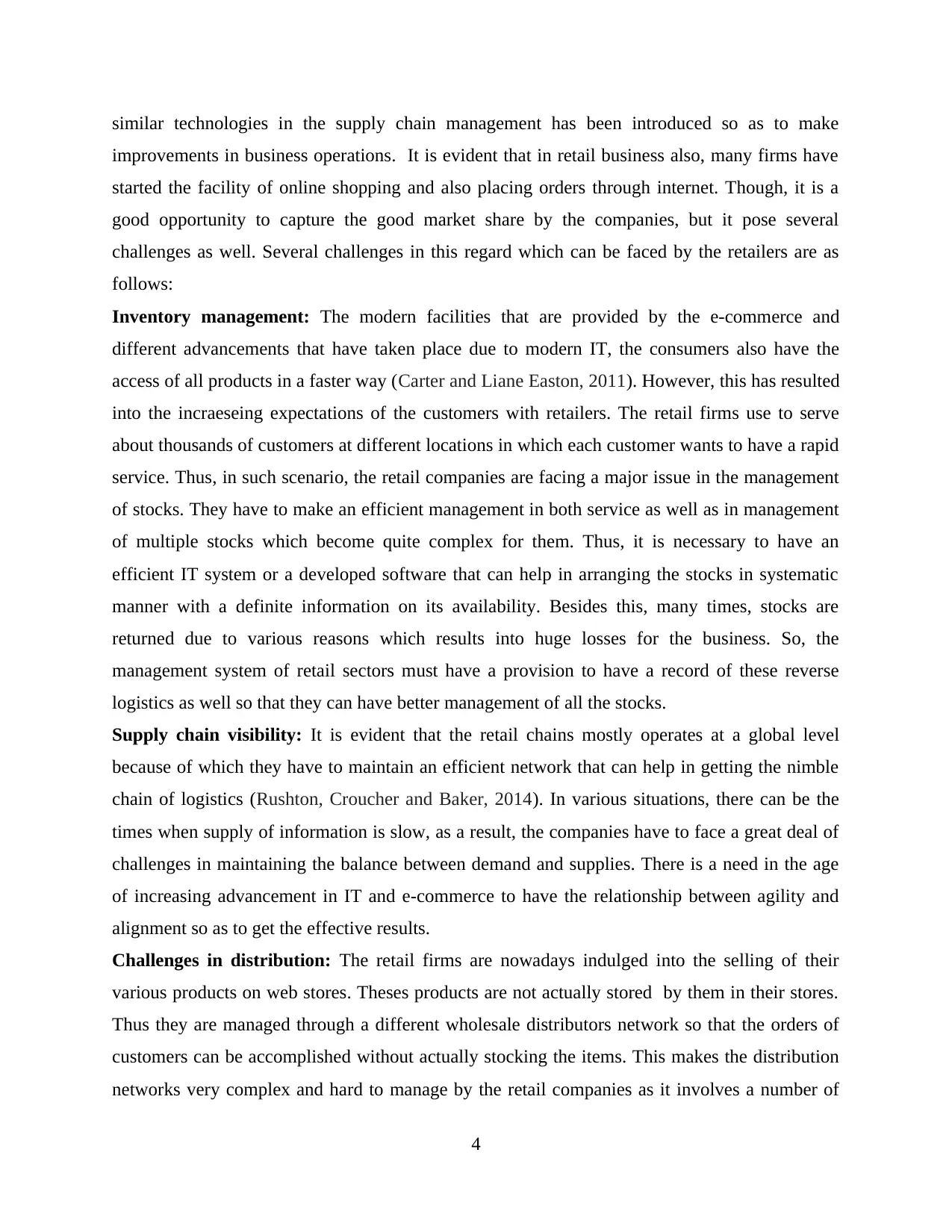
similar technologies in the supply chain management has been introduced so as to make
improvements in business operations. It is evident that in retail business also, many firms have
started the facility of online shopping and also placing orders through internet. Though, it is a
good opportunity to capture the good market share by the companies, but it pose several
challenges as well. Several challenges in this regard which can be faced by the retailers are as
follows:
Inventory management: The modern facilities that are provided by the e-commerce and
different advancements that have taken place due to modern IT, the consumers also have the
access of all products in a faster way (Carter and Liane Easton, 2011). However, this has resulted
into the incraeseing expectations of the customers with retailers. The retail firms use to serve
about thousands of customers at different locations in which each customer wants to have a rapid
service. Thus, in such scenario, the retail companies are facing a major issue in the management
of stocks. They have to make an efficient management in both service as well as in management
of multiple stocks which become quite complex for them. Thus, it is necessary to have an
efficient IT system or a developed software that can help in arranging the stocks in systematic
manner with a definite information on its availability. Besides this, many times, stocks are
returned due to various reasons which results into huge losses for the business. So, the
management system of retail sectors must have a provision to have a record of these reverse
logistics as well so that they can have better management of all the stocks.
Supply chain visibility: It is evident that the retail chains mostly operates at a global level
because of which they have to maintain an efficient network that can help in getting the nimble
chain of logistics (Rushton, Croucher and Baker, 2014). In various situations, there can be the
times when supply of information is slow, as a result, the companies have to face a great deal of
challenges in maintaining the balance between demand and supplies. There is a need in the age
of increasing advancement in IT and e-commerce to have the relationship between agility and
alignment so as to get the effective results.
Challenges in distribution: The retail firms are nowadays indulged into the selling of their
various products on web stores. Theses products are not actually stored by them in their stores.
Thus they are managed through a different wholesale distributors network so that the orders of
customers can be accomplished without actually stocking the items. This makes the distribution
networks very complex and hard to manage by the retail companies as it involves a number of
4
improvements in business operations. It is evident that in retail business also, many firms have
started the facility of online shopping and also placing orders through internet. Though, it is a
good opportunity to capture the good market share by the companies, but it pose several
challenges as well. Several challenges in this regard which can be faced by the retailers are as
follows:
Inventory management: The modern facilities that are provided by the e-commerce and
different advancements that have taken place due to modern IT, the consumers also have the
access of all products in a faster way (Carter and Liane Easton, 2011). However, this has resulted
into the incraeseing expectations of the customers with retailers. The retail firms use to serve
about thousands of customers at different locations in which each customer wants to have a rapid
service. Thus, in such scenario, the retail companies are facing a major issue in the management
of stocks. They have to make an efficient management in both service as well as in management
of multiple stocks which become quite complex for them. Thus, it is necessary to have an
efficient IT system or a developed software that can help in arranging the stocks in systematic
manner with a definite information on its availability. Besides this, many times, stocks are
returned due to various reasons which results into huge losses for the business. So, the
management system of retail sectors must have a provision to have a record of these reverse
logistics as well so that they can have better management of all the stocks.
Supply chain visibility: It is evident that the retail chains mostly operates at a global level
because of which they have to maintain an efficient network that can help in getting the nimble
chain of logistics (Rushton, Croucher and Baker, 2014). In various situations, there can be the
times when supply of information is slow, as a result, the companies have to face a great deal of
challenges in maintaining the balance between demand and supplies. There is a need in the age
of increasing advancement in IT and e-commerce to have the relationship between agility and
alignment so as to get the effective results.
Challenges in distribution: The retail firms are nowadays indulged into the selling of their
various products on web stores. Theses products are not actually stored by them in their stores.
Thus they are managed through a different wholesale distributors network so that the orders of
customers can be accomplished without actually stocking the items. This makes the distribution
networks very complex and hard to manage by the retail companies as it involves a number of
4
Paraphrase This Document
Need a fresh take? Get an instant paraphrase of this document with our AI Paraphraser
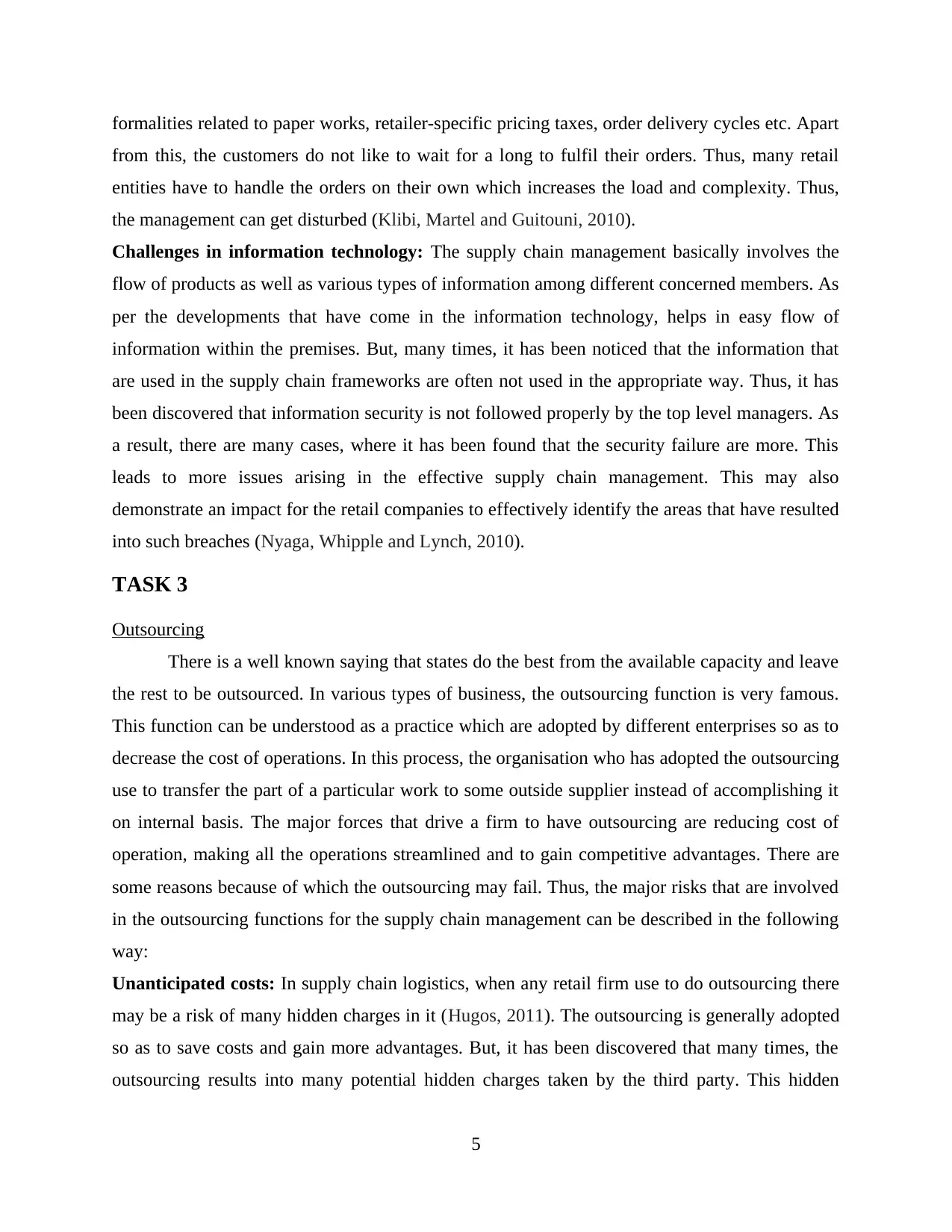
formalities related to paper works, retailer-specific pricing taxes, order delivery cycles etc. Apart
from this, the customers do not like to wait for a long to fulfil their orders. Thus, many retail
entities have to handle the orders on their own which increases the load and complexity. Thus,
the management can get disturbed (Klibi, Martel and Guitouni, 2010).
Challenges in information technology: The supply chain management basically involves the
flow of products as well as various types of information among different concerned members. As
per the developments that have come in the information technology, helps in easy flow of
information within the premises. But, many times, it has been noticed that the information that
are used in the supply chain frameworks are often not used in the appropriate way. Thus, it has
been discovered that information security is not followed properly by the top level managers. As
a result, there are many cases, where it has been found that the security failure are more. This
leads to more issues arising in the effective supply chain management. This may also
demonstrate an impact for the retail companies to effectively identify the areas that have resulted
into such breaches (Nyaga, Whipple and Lynch, 2010).
TASK 3
Outsourcing
There is a well known saying that states do the best from the available capacity and leave
the rest to be outsourced. In various types of business, the outsourcing function is very famous.
This function can be understood as a practice which are adopted by different enterprises so as to
decrease the cost of operations. In this process, the organisation who has adopted the outsourcing
use to transfer the part of a particular work to some outside supplier instead of accomplishing it
on internal basis. The major forces that drive a firm to have outsourcing are reducing cost of
operation, making all the operations streamlined and to gain competitive advantages. There are
some reasons because of which the outsourcing may fail. Thus, the major risks that are involved
in the outsourcing functions for the supply chain management can be described in the following
way:
Unanticipated costs: In supply chain logistics, when any retail firm use to do outsourcing there
may be a risk of many hidden charges in it (Hugos, 2011). The outsourcing is generally adopted
so as to save costs and gain more advantages. But, it has been discovered that many times, the
outsourcing results into many potential hidden charges taken by the third party. This hidden
5
from this, the customers do not like to wait for a long to fulfil their orders. Thus, many retail
entities have to handle the orders on their own which increases the load and complexity. Thus,
the management can get disturbed (Klibi, Martel and Guitouni, 2010).
Challenges in information technology: The supply chain management basically involves the
flow of products as well as various types of information among different concerned members. As
per the developments that have come in the information technology, helps in easy flow of
information within the premises. But, many times, it has been noticed that the information that
are used in the supply chain frameworks are often not used in the appropriate way. Thus, it has
been discovered that information security is not followed properly by the top level managers. As
a result, there are many cases, where it has been found that the security failure are more. This
leads to more issues arising in the effective supply chain management. This may also
demonstrate an impact for the retail companies to effectively identify the areas that have resulted
into such breaches (Nyaga, Whipple and Lynch, 2010).
TASK 3
Outsourcing
There is a well known saying that states do the best from the available capacity and leave
the rest to be outsourced. In various types of business, the outsourcing function is very famous.
This function can be understood as a practice which are adopted by different enterprises so as to
decrease the cost of operations. In this process, the organisation who has adopted the outsourcing
use to transfer the part of a particular work to some outside supplier instead of accomplishing it
on internal basis. The major forces that drive a firm to have outsourcing are reducing cost of
operation, making all the operations streamlined and to gain competitive advantages. There are
some reasons because of which the outsourcing may fail. Thus, the major risks that are involved
in the outsourcing functions for the supply chain management can be described in the following
way:
Unanticipated costs: In supply chain logistics, when any retail firm use to do outsourcing there
may be a risk of many hidden charges in it (Hugos, 2011). The outsourcing is generally adopted
so as to save costs and gain more advantages. But, it has been discovered that many times, the
outsourcing results into many potential hidden charges taken by the third party. This hidden
5
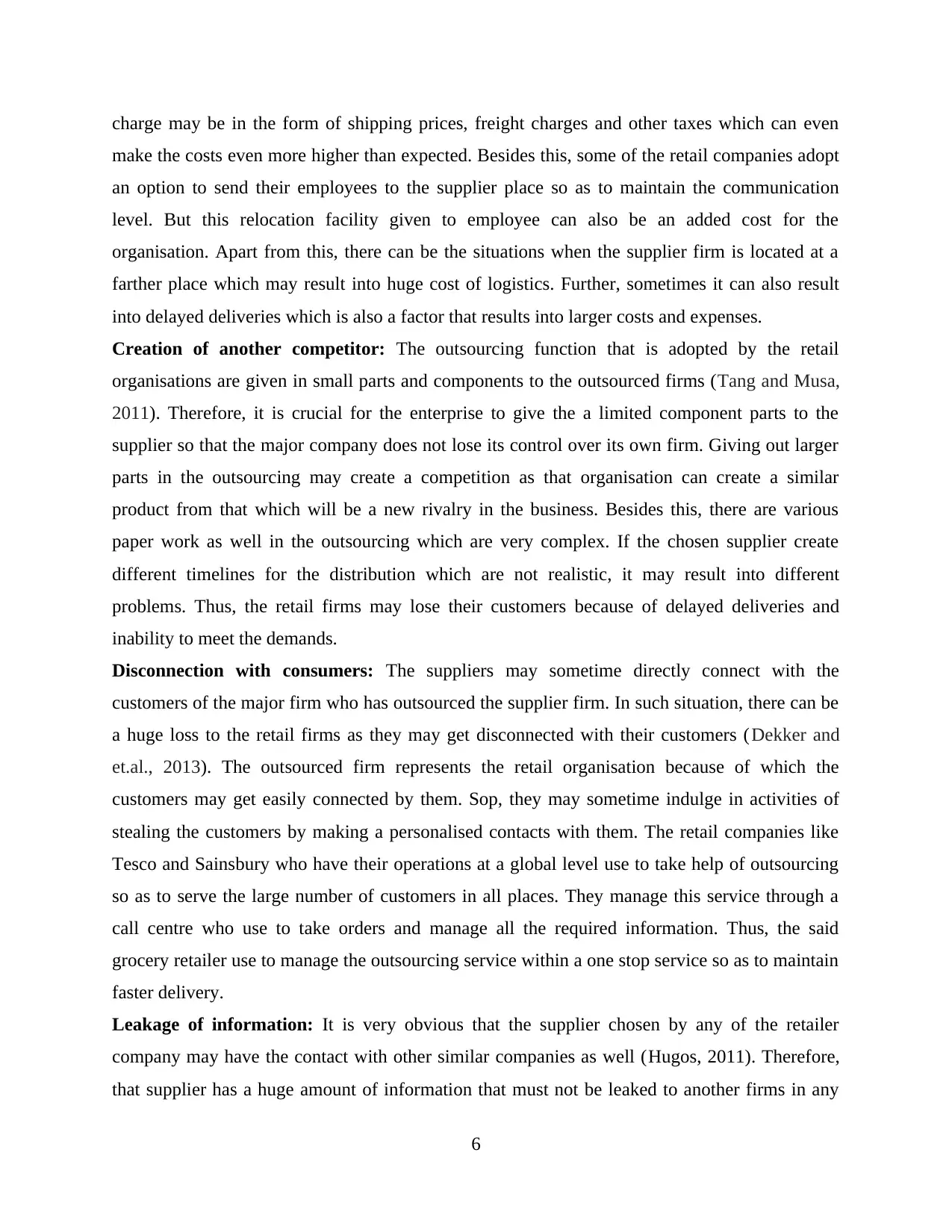
charge may be in the form of shipping prices, freight charges and other taxes which can even
make the costs even more higher than expected. Besides this, some of the retail companies adopt
an option to send their employees to the supplier place so as to maintain the communication
level. But this relocation facility given to employee can also be an added cost for the
organisation. Apart from this, there can be the situations when the supplier firm is located at a
farther place which may result into huge cost of logistics. Further, sometimes it can also result
into delayed deliveries which is also a factor that results into larger costs and expenses.
Creation of another competitor: The outsourcing function that is adopted by the retail
organisations are given in small parts and components to the outsourced firms (Tang and Musa,
2011). Therefore, it is crucial for the enterprise to give the a limited component parts to the
supplier so that the major company does not lose its control over its own firm. Giving out larger
parts in the outsourcing may create a competition as that organisation can create a similar
product from that which will be a new rivalry in the business. Besides this, there are various
paper work as well in the outsourcing which are very complex. If the chosen supplier create
different timelines for the distribution which are not realistic, it may result into different
problems. Thus, the retail firms may lose their customers because of delayed deliveries and
inability to meet the demands.
Disconnection with consumers: The suppliers may sometime directly connect with the
customers of the major firm who has outsourced the supplier firm. In such situation, there can be
a huge loss to the retail firms as they may get disconnected with their customers ( Dekker and
et.al., 2013). The outsourced firm represents the retail organisation because of which the
customers may get easily connected by them. Sop, they may sometime indulge in activities of
stealing the customers by making a personalised contacts with them. The retail companies like
Tesco and Sainsbury who have their operations at a global level use to take help of outsourcing
so as to serve the large number of customers in all places. They manage this service through a
call centre who use to take orders and manage all the required information. Thus, the said
grocery retailer use to manage the outsourcing service within a one stop service so as to maintain
faster delivery.
Leakage of information: It is very obvious that the supplier chosen by any of the retailer
company may have the contact with other similar companies as well (Hugos, 2011). Therefore,
that supplier has a huge amount of information that must not be leaked to another firms in any
6
make the costs even more higher than expected. Besides this, some of the retail companies adopt
an option to send their employees to the supplier place so as to maintain the communication
level. But this relocation facility given to employee can also be an added cost for the
organisation. Apart from this, there can be the situations when the supplier firm is located at a
farther place which may result into huge cost of logistics. Further, sometimes it can also result
into delayed deliveries which is also a factor that results into larger costs and expenses.
Creation of another competitor: The outsourcing function that is adopted by the retail
organisations are given in small parts and components to the outsourced firms (Tang and Musa,
2011). Therefore, it is crucial for the enterprise to give the a limited component parts to the
supplier so that the major company does not lose its control over its own firm. Giving out larger
parts in the outsourcing may create a competition as that organisation can create a similar
product from that which will be a new rivalry in the business. Besides this, there are various
paper work as well in the outsourcing which are very complex. If the chosen supplier create
different timelines for the distribution which are not realistic, it may result into different
problems. Thus, the retail firms may lose their customers because of delayed deliveries and
inability to meet the demands.
Disconnection with consumers: The suppliers may sometime directly connect with the
customers of the major firm who has outsourced the supplier firm. In such situation, there can be
a huge loss to the retail firms as they may get disconnected with their customers ( Dekker and
et.al., 2013). The outsourced firm represents the retail organisation because of which the
customers may get easily connected by them. Sop, they may sometime indulge in activities of
stealing the customers by making a personalised contacts with them. The retail companies like
Tesco and Sainsbury who have their operations at a global level use to take help of outsourcing
so as to serve the large number of customers in all places. They manage this service through a
call centre who use to take orders and manage all the required information. Thus, the said
grocery retailer use to manage the outsourcing service within a one stop service so as to maintain
faster delivery.
Leakage of information: It is very obvious that the supplier chosen by any of the retailer
company may have the contact with other similar companies as well (Hugos, 2011). Therefore,
that supplier has a huge amount of information that must not be leaked to another firms in any
6
⊘ This is a preview!⊘
Do you want full access?
Subscribe today to unlock all pages.

Trusted by 1+ million students worldwide
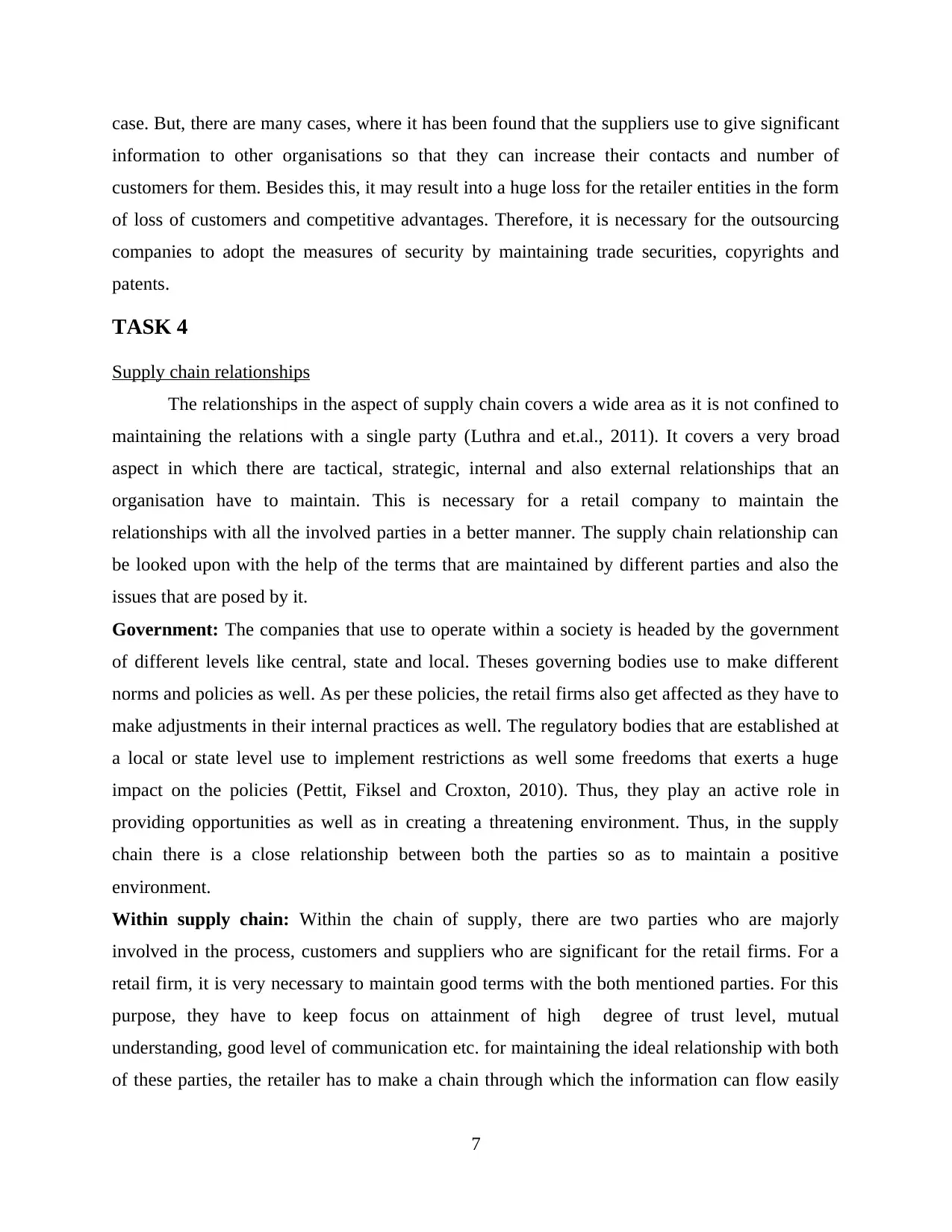
case. But, there are many cases, where it has been found that the suppliers use to give significant
information to other organisations so that they can increase their contacts and number of
customers for them. Besides this, it may result into a huge loss for the retailer entities in the form
of loss of customers and competitive advantages. Therefore, it is necessary for the outsourcing
companies to adopt the measures of security by maintaining trade securities, copyrights and
patents.
TASK 4
Supply chain relationships
The relationships in the aspect of supply chain covers a wide area as it is not confined to
maintaining the relations with a single party (Luthra and et.al., 2011). It covers a very broad
aspect in which there are tactical, strategic, internal and also external relationships that an
organisation have to maintain. This is necessary for a retail company to maintain the
relationships with all the involved parties in a better manner. The supply chain relationship can
be looked upon with the help of the terms that are maintained by different parties and also the
issues that are posed by it.
Government: The companies that use to operate within a society is headed by the government
of different levels like central, state and local. Theses governing bodies use to make different
norms and policies as well. As per these policies, the retail firms also get affected as they have to
make adjustments in their internal practices as well. The regulatory bodies that are established at
a local or state level use to implement restrictions as well some freedoms that exerts a huge
impact on the policies (Pettit, Fiksel and Croxton, 2010). Thus, they play an active role in
providing opportunities as well as in creating a threatening environment. Thus, in the supply
chain there is a close relationship between both the parties so as to maintain a positive
environment.
Within supply chain: Within the chain of supply, there are two parties who are majorly
involved in the process, customers and suppliers who are significant for the retail firms. For a
retail firm, it is very necessary to maintain good terms with the both mentioned parties. For this
purpose, they have to keep focus on attainment of high degree of trust level, mutual
understanding, good level of communication etc. for maintaining the ideal relationship with both
of these parties, the retailer has to make a chain through which the information can flow easily
7
information to other organisations so that they can increase their contacts and number of
customers for them. Besides this, it may result into a huge loss for the retailer entities in the form
of loss of customers and competitive advantages. Therefore, it is necessary for the outsourcing
companies to adopt the measures of security by maintaining trade securities, copyrights and
patents.
TASK 4
Supply chain relationships
The relationships in the aspect of supply chain covers a wide area as it is not confined to
maintaining the relations with a single party (Luthra and et.al., 2011). It covers a very broad
aspect in which there are tactical, strategic, internal and also external relationships that an
organisation have to maintain. This is necessary for a retail company to maintain the
relationships with all the involved parties in a better manner. The supply chain relationship can
be looked upon with the help of the terms that are maintained by different parties and also the
issues that are posed by it.
Government: The companies that use to operate within a society is headed by the government
of different levels like central, state and local. Theses governing bodies use to make different
norms and policies as well. As per these policies, the retail firms also get affected as they have to
make adjustments in their internal practices as well. The regulatory bodies that are established at
a local or state level use to implement restrictions as well some freedoms that exerts a huge
impact on the policies (Pettit, Fiksel and Croxton, 2010). Thus, they play an active role in
providing opportunities as well as in creating a threatening environment. Thus, in the supply
chain there is a close relationship between both the parties so as to maintain a positive
environment.
Within supply chain: Within the chain of supply, there are two parties who are majorly
involved in the process, customers and suppliers who are significant for the retail firms. For a
retail firm, it is very necessary to maintain good terms with the both mentioned parties. For this
purpose, they have to keep focus on attainment of high degree of trust level, mutual
understanding, good level of communication etc. for maintaining the ideal relationship with both
of these parties, the retailer has to make a chain through which the information can flow easily
7
Paraphrase This Document
Need a fresh take? Get an instant paraphrase of this document with our AI Paraphraser
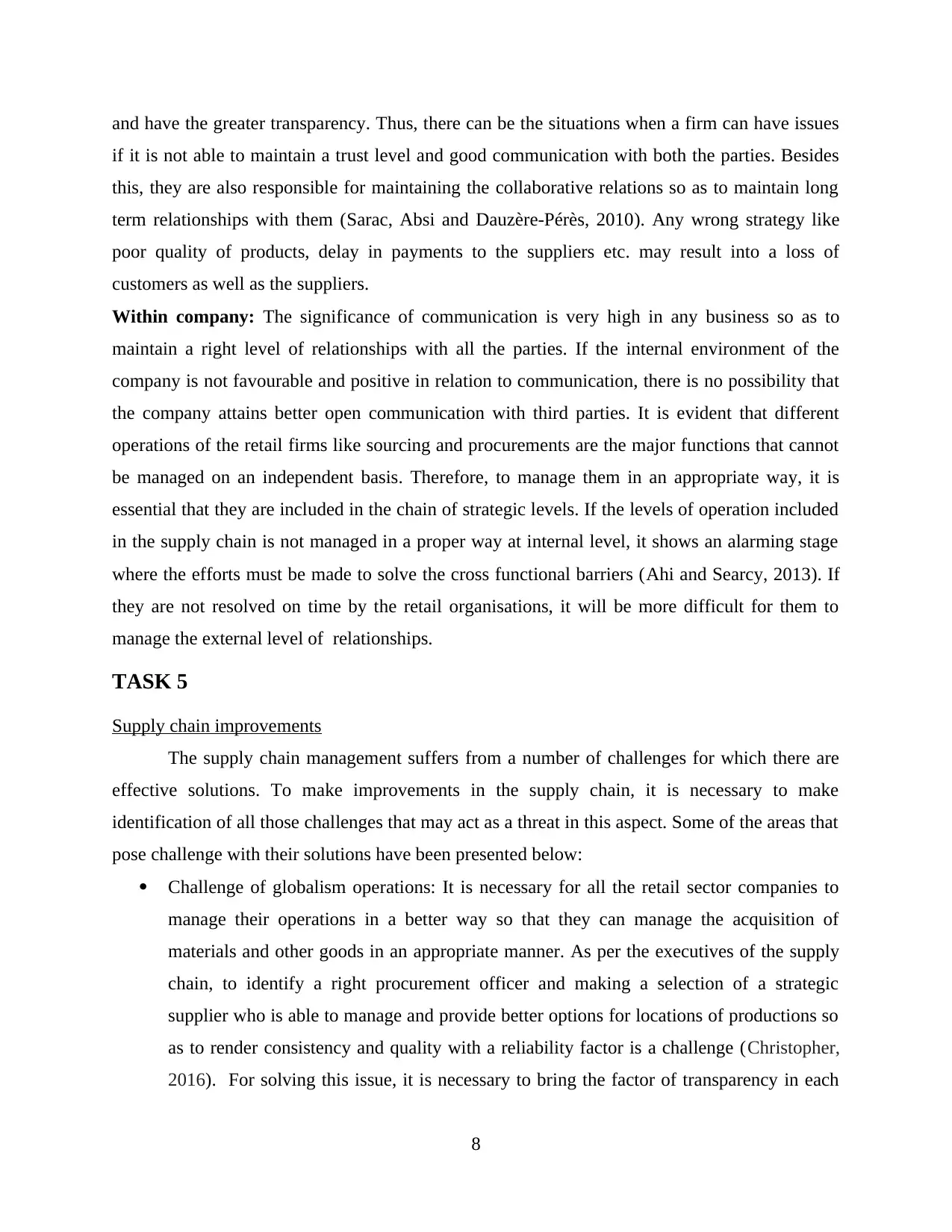
and have the greater transparency. Thus, there can be the situations when a firm can have issues
if it is not able to maintain a trust level and good communication with both the parties. Besides
this, they are also responsible for maintaining the collaborative relations so as to maintain long
term relationships with them (Sarac, Absi and Dauzère-Pérès, 2010). Any wrong strategy like
poor quality of products, delay in payments to the suppliers etc. may result into a loss of
customers as well as the suppliers.
Within company: The significance of communication is very high in any business so as to
maintain a right level of relationships with all the parties. If the internal environment of the
company is not favourable and positive in relation to communication, there is no possibility that
the company attains better open communication with third parties. It is evident that different
operations of the retail firms like sourcing and procurements are the major functions that cannot
be managed on an independent basis. Therefore, to manage them in an appropriate way, it is
essential that they are included in the chain of strategic levels. If the levels of operation included
in the supply chain is not managed in a proper way at internal level, it shows an alarming stage
where the efforts must be made to solve the cross functional barriers (Ahi and Searcy, 2013). If
they are not resolved on time by the retail organisations, it will be more difficult for them to
manage the external level of relationships.
TASK 5
Supply chain improvements
The supply chain management suffers from a number of challenges for which there are
effective solutions. To make improvements in the supply chain, it is necessary to make
identification of all those challenges that may act as a threat in this aspect. Some of the areas that
pose challenge with their solutions have been presented below:
Challenge of globalism operations: It is necessary for all the retail sector companies to
manage their operations in a better way so that they can manage the acquisition of
materials and other goods in an appropriate manner. As per the executives of the supply
chain, to identify a right procurement officer and making a selection of a strategic
supplier who is able to manage and provide better options for locations of productions so
as to render consistency and quality with a reliability factor is a challenge (Christopher,
2016). For solving this issue, it is necessary to bring the factor of transparency in each
8
if it is not able to maintain a trust level and good communication with both the parties. Besides
this, they are also responsible for maintaining the collaborative relations so as to maintain long
term relationships with them (Sarac, Absi and Dauzère-Pérès, 2010). Any wrong strategy like
poor quality of products, delay in payments to the suppliers etc. may result into a loss of
customers as well as the suppliers.
Within company: The significance of communication is very high in any business so as to
maintain a right level of relationships with all the parties. If the internal environment of the
company is not favourable and positive in relation to communication, there is no possibility that
the company attains better open communication with third parties. It is evident that different
operations of the retail firms like sourcing and procurements are the major functions that cannot
be managed on an independent basis. Therefore, to manage them in an appropriate way, it is
essential that they are included in the chain of strategic levels. If the levels of operation included
in the supply chain is not managed in a proper way at internal level, it shows an alarming stage
where the efforts must be made to solve the cross functional barriers (Ahi and Searcy, 2013). If
they are not resolved on time by the retail organisations, it will be more difficult for them to
manage the external level of relationships.
TASK 5
Supply chain improvements
The supply chain management suffers from a number of challenges for which there are
effective solutions. To make improvements in the supply chain, it is necessary to make
identification of all those challenges that may act as a threat in this aspect. Some of the areas that
pose challenge with their solutions have been presented below:
Challenge of globalism operations: It is necessary for all the retail sector companies to
manage their operations in a better way so that they can manage the acquisition of
materials and other goods in an appropriate manner. As per the executives of the supply
chain, to identify a right procurement officer and making a selection of a strategic
supplier who is able to manage and provide better options for locations of productions so
as to render consistency and quality with a reliability factor is a challenge (Christopher,
2016). For solving this issue, it is necessary to bring the factor of transparency in each
8
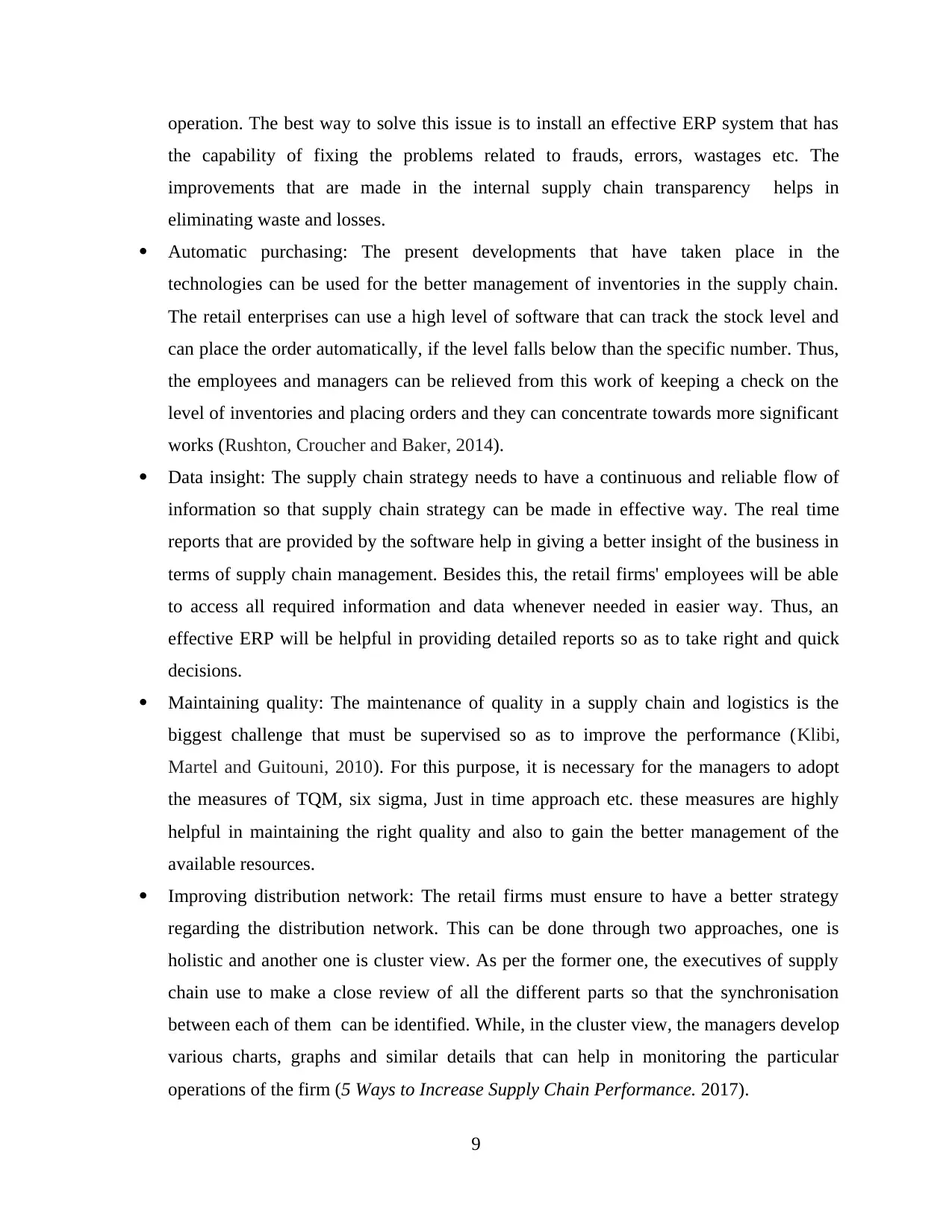
operation. The best way to solve this issue is to install an effective ERP system that has
the capability of fixing the problems related to frauds, errors, wastages etc. The
improvements that are made in the internal supply chain transparency helps in
eliminating waste and losses.
Automatic purchasing: The present developments that have taken place in the
technologies can be used for the better management of inventories in the supply chain.
The retail enterprises can use a high level of software that can track the stock level and
can place the order automatically, if the level falls below than the specific number. Thus,
the employees and managers can be relieved from this work of keeping a check on the
level of inventories and placing orders and they can concentrate towards more significant
works (Rushton, Croucher and Baker, 2014).
Data insight: The supply chain strategy needs to have a continuous and reliable flow of
information so that supply chain strategy can be made in effective way. The real time
reports that are provided by the software help in giving a better insight of the business in
terms of supply chain management. Besides this, the retail firms' employees will be able
to access all required information and data whenever needed in easier way. Thus, an
effective ERP will be helpful in providing detailed reports so as to take right and quick
decisions.
Maintaining quality: The maintenance of quality in a supply chain and logistics is the
biggest challenge that must be supervised so as to improve the performance (Klibi,
Martel and Guitouni, 2010). For this purpose, it is necessary for the managers to adopt
the measures of TQM, six sigma, Just in time approach etc. these measures are highly
helpful in maintaining the right quality and also to gain the better management of the
available resources.
Improving distribution network: The retail firms must ensure to have a better strategy
regarding the distribution network. This can be done through two approaches, one is
holistic and another one is cluster view. As per the former one, the executives of supply
chain use to make a close review of all the different parts so that the synchronisation
between each of them can be identified. While, in the cluster view, the managers develop
various charts, graphs and similar details that can help in monitoring the particular
operations of the firm (5 Ways to Increase Supply Chain Performance. 2017).
9
the capability of fixing the problems related to frauds, errors, wastages etc. The
improvements that are made in the internal supply chain transparency helps in
eliminating waste and losses.
Automatic purchasing: The present developments that have taken place in the
technologies can be used for the better management of inventories in the supply chain.
The retail enterprises can use a high level of software that can track the stock level and
can place the order automatically, if the level falls below than the specific number. Thus,
the employees and managers can be relieved from this work of keeping a check on the
level of inventories and placing orders and they can concentrate towards more significant
works (Rushton, Croucher and Baker, 2014).
Data insight: The supply chain strategy needs to have a continuous and reliable flow of
information so that supply chain strategy can be made in effective way. The real time
reports that are provided by the software help in giving a better insight of the business in
terms of supply chain management. Besides this, the retail firms' employees will be able
to access all required information and data whenever needed in easier way. Thus, an
effective ERP will be helpful in providing detailed reports so as to take right and quick
decisions.
Maintaining quality: The maintenance of quality in a supply chain and logistics is the
biggest challenge that must be supervised so as to improve the performance (Klibi,
Martel and Guitouni, 2010). For this purpose, it is necessary for the managers to adopt
the measures of TQM, six sigma, Just in time approach etc. these measures are highly
helpful in maintaining the right quality and also to gain the better management of the
available resources.
Improving distribution network: The retail firms must ensure to have a better strategy
regarding the distribution network. This can be done through two approaches, one is
holistic and another one is cluster view. As per the former one, the executives of supply
chain use to make a close review of all the different parts so that the synchronisation
between each of them can be identified. While, in the cluster view, the managers develop
various charts, graphs and similar details that can help in monitoring the particular
operations of the firm (5 Ways to Increase Supply Chain Performance. 2017).
9
⊘ This is a preview!⊘
Do you want full access?
Subscribe today to unlock all pages.

Trusted by 1+ million students worldwide
1 out of 15
Related Documents
Your All-in-One AI-Powered Toolkit for Academic Success.
+13062052269
info@desklib.com
Available 24*7 on WhatsApp / Email
![[object Object]](/_next/static/media/star-bottom.7253800d.svg)
Unlock your academic potential
Copyright © 2020–2025 A2Z Services. All Rights Reserved. Developed and managed by ZUCOL.




